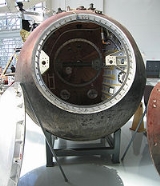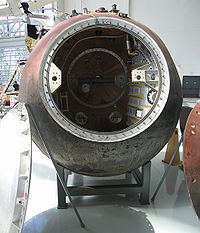
Foton
Encyclopedia

Russia
Russia or , officially known as both Russia and the Russian Federation , is a country in northern Eurasia. It is a federal semi-presidential republic, comprising 83 federal subjects...
n science satellite
Satellite
In the context of spaceflight, a satellite is an object which has been placed into orbit by human endeavour. Such objects are sometimes called artificial satellites to distinguish them from natural satellites such as the Moon....
and reentry vehicle programs. Although unmanned, the design was adapted from the manned Vostok spacecraft
Vostok spacecraft
The Vostok was a type of spacecraft built by the Soviet Union. The first human spaceflight in history was accomplished on this spacecraft on April 12, 1961, by Soviet cosmonaut Yuri Gagarin....
capsule. The primary focus of the Foton project is materials science
Materials science
Materials science is an interdisciplinary field applying the properties of matter to various areas of science and engineering. This scientific field investigates the relationship between the structure of materials at atomic or molecular scales and their macroscopic properties. It incorporates...
research, but some missions have also carried experiments for other fields of research including biology
Biology
Biology is a natural science concerned with the study of life and living organisms, including their structure, function, growth, origin, evolution, distribution, and taxonomy. Biology is a vast subject containing many subdivisions, topics, and disciplines...
. The original Foton series included 12 launches from the Plesetsk Cosmodrome
Plesetsk Cosmodrome
Plesetsk Cosmodrome is a Russian spaceport, located in Arkhangelsk Oblast, about 800 km north of Moscow and approximately 200 km south of Arkhangelsk.-Overview:...
from 1985 to 1999. The second series, under the name Foton-M
Foton-M
Foton-M is series of robotic spacecraft used by Russia and the European Space Agency for research conducted in the microgravity environment of Earth orbit. The Foton-M design is based on the design of the Foton, with several improvements including a new telemetry and telecommand unit for increased...
, incorporates many design improvements over the original Foton, and is still in use. So far, there have been three launch attempts of the Foton-M. The first was in 2002 from the Plesetsk Cosmodrome
Plesetsk Cosmodrome
Plesetsk Cosmodrome is a Russian spaceport, located in Arkhangelsk Oblast, about 800 km north of Moscow and approximately 200 km south of Arkhangelsk.-Overview:...
, which ended in failure
Foton-M1
Foton-M1 was an unmanned space mission by the European Space Agency aboard a Russian Soyuz-U rocket that failed to launch successfully. The rocket's payload consisted of 44 experiments prepared by the European Space Agency, Fluidpac, Biopan, Telescience Support Unit, and others...
due to a problem in the launch vehicle. The last two were from the Baikonur Cosmodrome
Baikonur Cosmodrome
The Baikonur Cosmodrome , also called Tyuratam, is the world's first and largest operational space launch facility. It is located in the desert steppe of Kazakhstan, about east of the Aral Sea, north of the Syr Darya river, near Tyuratam railway station, at 90 meters above sea level...
, one in 2005 and one in 2007, both were successful. Both the Foton and Foton-M series used Soyuz-U
Soyuz-U
The Soyuz-U launch vehicle is an improved version of the original Soyuz LV. Soyuz-U is part of the R-7 family of rockets based on the R-7 Semyorka missile. Members of this rocket family were designed by the TsSKB design bureau and constructed at the Progress Factory in Samara, Russia....
(11A511U and 11A511U2) rockets as launch vehicles.
Reentry
The Foton capsule has limited thruster capability. As such, the reentry path and orientation can not be controlled after the capsule has separated from the engine system. This means that the capsule has to be protected from reentry heat on all sides, thus explaining the spherical design (as opposed to Project Mercury's conical design), which allows for maximum volume while minimizing the external surface. However, the lack of lift means the capsule experiences high forces on reentry, up to 8 to 9g.ESA participation
Starting with the Foton-7 mission, the European Space AgencyEuropean Space Agency
The European Space Agency , established in 1975, is an intergovernmental organisation dedicated to the exploration of space, currently with 18 member states...
has been a partner in the Foton program.
Foton launches
| Designation | Launch Date | Recovery Date | Mission Payload(s) | Notes |
|---|---|---|---|---|
| Foton-1 | 1985-04-16 | ? | ||
| Foton-2 | 1986-05-21 | ? | ||
| Foton-3 | 1987-04-24 | ? | ||
| Foton-4 | 1988-04-14 | ? | ||
| Foton-5 | 1989-04-26 | ? | ||
| Foton-6 | 1990-04-11 | ? | On display at the Evergreen Aviation Museum Evergreen Aviation Museum The Evergreen Aviation & Space Museum is an aviation museum which displays a number of military and civilian aircraft and spacecraft, most notably, the Hughes H-4 Hercules "Spruce Goose". The museum is located in McMinnville, Oregon, across the street from the headquarters of Evergreen... |
|
| Foton-7 | 1991-10-04 | ? | ||
| Foton-8 | 1992-10-08 | ? | ||
| Foton-9 | 1994-06-14 | ? | ||
| Foton-10 | 1995-02-16 | ? | ||
| Foton-11 | 1997-10-09 | ? | ||
| Foton-12 | 1999-09-09 | ? | ||
| Foton-M1 Foton-M1 Foton-M1 was an unmanned space mission by the European Space Agency aboard a Russian Soyuz-U rocket that failed to launch successfully. The rocket's payload consisted of 44 experiments prepared by the European Space Agency, Fluidpac, Biopan, Telescience Support Unit, and others... |
2002-10-15 | N/A | Lost due to a launch failure | |
| Foton-M2 Foton-M2 The Foton-M2 was a space mission aboard an unmanned Foton-M spacecraft carrying a mainly European payload by the European Space Agency . It was placed into orbit by a Russian Soyuz-U launcher on 20 June 2005 at 14:00 Central European Time from the Baikonur Cosmodrome in Kazakhstan by the Russian... |
2005-05-31 | 2005-06-16 | ||
| Foton-M3 | 2007-09-14 | 2007-09-26 | Young Engineers' Satellite 2 Young Engineers' Satellite 2 The Young Engineers' Satellite 2 is a 36 kg student-built tether satellite that is part of ESA's Foton-M3 microgravity mission. The launch of the Russian Foton-M3 occurred on September 14, 2007 at 13:00 by a Soyuz-U launcher... |
External links
- Foton (from Encyclopedia Astronautica)
- Russian Space Web

